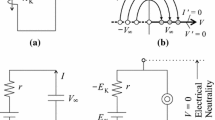Abstract
This paper demonstrates the derivation of Hodgkin-Huxley-like equations from the Fokker-Planck equation. The primary result is that instead of the familiar\(g_K = \hat g_K n^4 \) equation expressing the potassium conductance as a function of the variablen which obeys a first order differential equation, the expression\(g_K = g_o exp[L^2 - (n - L)^2 ]\), whereL = 2.7, is to be used. This form is obtained by solving analytically an approximate solution to a Fokker-Planck partial difference equation. Instead of the Hodgkin-Huxley interpretation as the probability of occupying the conducting state, the parameter n(t) is now interpreted as the position of the “peak” of the population distribution function P(N, t), which changes in time described by the Fokker-Planck equation.
This new approach enables close fitting of the experimental voltage clamp data for potassium conductance. In addition, the Cole-Moore shift paradox can be quantitatively explained in terms of the shift of the distribution function P(N,t) by the initial clamped transmembrane potentialV i before the final clamped transmembrane potentialV f is applied, thus increasing the time necessary for the establishment of equilibrium.
Similar content being viewed by others
References
A. L. Hodgkin and A. F. Huxley, A quantitative description of membrane current and its application to conduction and excitation in nerve,Journal of Physiology,117:500–544 (1952).
K. S. Cole and J. W. Moore, Potassium ion current in the squid giant axon: dynamic characteristic,Biophysical Journal,1:1–14 (1960).
R. Hoyt, 1963. The squid giant axon mathematical models,Biophysical Journal,3:399–431 (1963).
D. E. Goldman, A molecular structural basis for the excitation properties of axons,Biophysical Journal,4:167–188 (1964).
J. Tille, A new interpretation of the dynamical changes of the potassium conductances in the squid giant axon,Biophysical Journal,5:163–171 (1965).
D. Wobschall, An electret model of the nerve membrane,Journal of Theoretical Biology,21:439–448(1968).
J. W. Moore and E. B. Cox, A kinetic model for the sodium conductance system in squid axons,Biophysical Journal,16:171–192 (1976).
B. Hille, Ionic channels in excitable membranes, current problems and biophysical approaches,Biophysical Journal,22:283–294 (1978).
C. C. Lo,Electrodynamics of ion conduction in nerve axons, Sc. D. Dissertation, Massachusetts Institute of Technology, 1980.
M. W. P. Strandberg, Homomorphism on a physical system of the Hodgkin and Huxley equations for ion conductance in nerve,Journal of Theoretical Biology 117:509–527 (1985).
L. S. Liebovitch, J. Fischbarg, and J. P. Koniarek, Ion channel kinetics: a model based on fractal scaling rather than multistate Markov processes,Math. Biosci. 84:37–68 (1987).
N. J. Abbott, R. Williamson, and L. Maddock, Editors,Cephalopod Neurobiology: Neuroscience studies in squid, octopus, and cuttlefish, Oxford University Press, 1995.
M. W. P. Strandberg, 1976. Action potential in giant axon of Loligo: a physical model,Journal of Theoretical Biology,58:33–53 (1976).
K. Eyring,Deformation Kinetics, John Wiley and sons, 1975.
L. E. Moore, H. M. Fishman, and D. M. J. Poussart, Small-signal analysis of potassium conduction in squid (Loligo pealei) axons,Journal of Membrane Biology,5:157–164 (1980).
S. H. Young, and J. W. Moore, Potassium currents in the crayfish giant axon, dynamic characteristics,Biophysical Journal,36:723–733 (1981).
Author information
Authors and Affiliations
Rights and permissions
About this article
Cite this article
Lo, C., Yam, Y. Derivation of an Improved Hodgkin-Huxley Model for Potassium Channel by Means of the Fokker-Planck Equation. J Stat Phys 89, 997–1016 (1997). https://doi.org/10.1007/BF02764218
Received:
Revised:
Issue Date:
DOI: https://doi.org/10.1007/BF02764218




